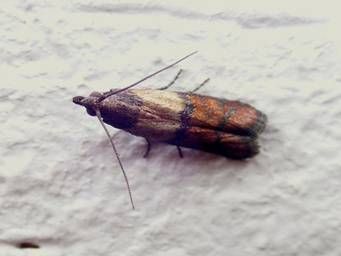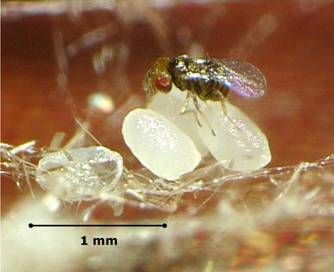Food moths (Indian meal moths, Mediterranean flour moths or Angoumois grain moths) are widely spread pests in households and food storage and processing companies. Endangered goods are cereal products, nuts, spices, teas, pasta, various sweets, like chocolate, but also dry food for pets, especially bird seed and grain feed. The larvae can ideally develop here.
An infestation by food moths is not only unappetizing, but also hazardous to health. The feeding activity of the larvae spoils the food. The consumption of infested food can cause allergic reactions, mucous membrane irritations and bowel diseases.
Besides, mites and various fungi might settle on the fecal residues. Therefore infested food should be disposed.
In the household, the `food moth` or Indian meal moth Plodia interpunctella is the most common one.
Appearance of the food moth:
The moths are very easy to recognize by the distinctive coloring of the wings (bronze bands on a silver background on the forewings), size about 1 to 1.5 cm. The larvae are yellowish-white and become up to 1.5 cm in size.



Way of life of the moths:
The female moths lay their eggs (200-300 eggs / female) on or in close proximity to food. Shortly thereafter the small larvae hatch and immediately start eating. Afterwards the larvae walk around and search for a suitable hiding place for pupation. At normal room temperatures, the larval development takes about 4-6 weeks. After another 10 days the next generation of moths hatches, the females lay eggs again and the cycle starts again.
Main reason for moth infestation in the household is the wrong and overlong storage of food.
To prevent spread, a few simple basic rules should be observed:
- Pests often get into the house with the purchases. Always check food before purchasing or at the latest before storing in the cupboard for an infestation (an infestation can be recognized by spun small droppings, gossamer or feeding damage in/on the packaging)
- Storage only in tight-closing glasses or storage containers. Paper and film packagings do not offer safe protection against larvae.
- Do no store large quantities. The longer food is stored the higher is the risk of an infestation. Regularly control nuts, almond slices, raisins and other baking ingredients that are often stored for a very long time. Opened packages should always be filled into closed containers.
- Always store stocks in a dry and, if possible, cool place.
- Built-in kitchens offer many hiding places for moths. Therefore the cupboards should be thoroughly cleaned and vacuumed twice a year. Gaps can also be treated with hot air (hair dryer).
- Pheromone traps only serve for control purposes and are no effective control agent. Only males are trapped, the females continue to lay eggs.
- Secure the windows in summer with fly screens to prevent flying in from the neighborhood.
- Be careful when using insecticides as they may also have an effect on humans.
- If all measures do not solve the problem, parasitic wasps must be used against the food moths. The tiny parasitic wasps (smaller than 0.5 mm) are able to control the moths effectively, environmentally friendly, discretely and sustainably.
The TrichoKarte is an application system for the Trichogramma parasitic wasps developed by us and tried and tested in the practice for many years.
It has already been used a million times outdoors, in greenhouse growing, in stock-keeping and private households.
The TrichoKarte VORRAT is fitted standardly with 2000 parasitized eggs of the Trichogramma parasitic wasp T. evanescens euproctidis (for a release every 14 days) or 3000 parasitized eggs (for a release every 21 days).
We have defined quality standards for our products. They are the basis for a successful control of the moths and the overall success of the procedure!



Biological control of moths in the household
Trichogramma parasitic wasps are egg parasites, that means they look for the laid eggs of moths, lay their own eggs inside and instead of a moth larvae a new beneficial parasitic wasp hatches. This cycle repeats as long as there are moth eggs available. When the parasitic wasps do not find moth eggs anymore, they die.
To effectively break the development cycle of the moths, we recommend 4 releases of the parasitic wasps at 14 day intervals. With each release, 4 TrichoKarten, each fitted with about 2000 parasitic wasps eggs, are distributed close to the stocks. Like a mini-subscription, the cards are sent automatically at 14 day intervals.
The quality is decisive!
We have been breeding Trichogramma parasitic wasps for more than 20 years to biologically control different lepidopteran pests. The breeding and the provision of beneficial insects for a successful control requires a lot of experience and care.
Our application systems, like the TrichoKarte, have been tested and have been established in practice for many years. Especially for the use of beneficial insects a good consultation is important so that the beneficial insects work successfully.
You can purchase our beneficial insects on the TrichoKarte with different partners or online shops.




